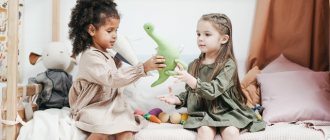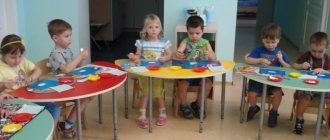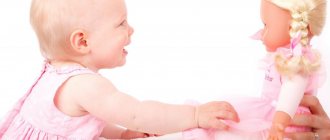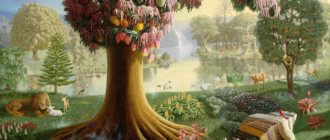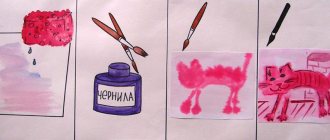Development of creative abilities in preschool children in visual arts
Everything that a person subsequently assimilates never has the same depth as everything learned in childhood.
K. D. Ushinsky
Introducing children to the fine arts and introducing them to artistic creativity begins already from preschool age, since this is one of the recognized ways of forming a personality and developing its creative potential.
Arousing interest in the world around us, realizing oneself in it, reflecting a personal impression of something, developing imagination and fantasy, cultivating emotional responsiveness, arousing children’s desire to see beauty in the world around them, forming an aesthetic attitude towards the world and much more will help the child, just like us It seems that it is artistic creativity, the development of which, therefore, should begin as early as possible.
From a very early age, children try to reflect their impressions of the world around them in their visual creativity through visual sensations. At first, the “paintings” created by the children, the so-called “doodles,” are understandable only to the “artists” themselves. At an early stage, they sometimes don't need paints, brushes and pencils. Kids draw with their fingers, palms on foggy glass, a stick on the sand, chalk on the asphalt, sometimes mother’s unattended lipstick or paste on the mirror, water spilled on the table, they make images with buttons or beads taken from their grandmother’s box. That is, everything that can leave a visible trace. At the same time, children not only reflect what they see and feel, but also get acquainted with materials and objects of different properties and qualities.
As they get older, preschoolers first acquire the simplest skills and abilities of drawing using traditional methods and means. And over time, they meaningfully seek out new techniques for reflecting the surrounding reality in their own artistic creativity. At that moment, the teacher can make this work purposeful and introduce children to non-traditional techniques that take place in the fine arts. Include the most unusual means of image in the educational process: paraffin candle, comb, toothbrush, cotton swab, thread and much more. This is a free creative process, when the word “impossible” is not present, but there is an opportunity to break the rules of using certain materials: but with your finger and paint. Carrying out such classes helps to relieve children's fears, gain faith in their strengths, internal harmony with themselves and the world around them, and will give children a new wide range of sensations that will become richer, fuller and brighter.
For our work, we choose the topic of non-traditional drawing techniques because it is interesting to both educators and our children. All of them, without exception, quickly and willingly get involved in work in class, and after completing it they react very emotionally to the result of their work - their drawing. Our students love to draw using techniques such as finger painting. Drawing in this unconventional technique brings great joy to children, liberates them and increases their self-esteem. They also like the potato signet print. Printing with signets allows children to be prepared for subsequent depictions of objects in the surrounding world from life, learning compositional drawing, and teaching them to coordinate hand movements. A poke with a hard, semi-dry brush. This method of drawing allows you to give the drawing the necessary expressiveness and realism, and the child gets pleasure from his work. Wax crayons and watercolors. This drawing technique is used to create the desired general tone or background of the picture, for example: sky, sand, water, etc. Also in our work we use such types of non-traditional drawing techniques as: monotype, blotography, spraying, scratching, batik and others.
We know that artistic abilities reveal themselves earlier than others. Children are gifted in all types of art, but they received the most lasting recognition in art, and it is not surprising, because the product of their activity - drawings - can be stored, exhibited, studied as evidence of the talent of the little author. Children have rich prerequisites for the development of not only artistic, but also creativity in general. The child has not yet built an impenetrable wall between “I” and “not I.” He is ready to treat everything as if it were alive, to see in any object and phenomenon the soul, character, aspiration - everything that is inherent in himself. The child develops his own attitude, his own understanding of the subject, it is no coincidence that even color for the baby is a means of expressing the attitude towards the subject: dark, careless tones and lines - “bad, evil, scary”; and vice versa, bright, light colors for beautiful, beloved, kind drawings. Imagination for a young artist is not ingenuity, not originality, but the ability to create a sensual image that expressively reveals the unique inner content. Gifted children often make “banal images,” but the former are distinguished not by “what” they depict, but by “how” and “for what” they do it.
One of the distinctive signs of talent in the visual arts will be the expressiveness of color schemes, non-subordination to patterns, “speaking” color; greater dynamism of the drawings. But for visual talent, more than for others, there is a certain “age-related talent” that rolls over all children, and then, in almost all of them, fades away. Of course, we understand that in children’s artistic activities important aspects of age-related development are realized, then these possibilities turn out to be exhausted and development finds another path, or the child draws haphazardly, “wrongly” - and that’s the beauty of it. We want to say that artistic activity is somewhat specific. In art there can be no assessment of “right or wrong” - otherwise there would not be a huge variety of artists, but there would be one single standard accepted as a model. Moreover, artists who go “far” from templates, from the real vision of the world are called genius: Pablo Picasso, Salvador Dali, Hieronymus Bosch. But what about the greatest painting by Kazemir Malevich “Black Square”, if we evaluate it only from the position of naturalistic illusionism - an adequate depiction of purely objective relations?
Genius is hidden not in the form, but in the deep content of the drawing, not “how” it is written, but “for what.” That is why in our work we set the primary goal of educating and developing artistically gifted children not to master graphic skills, but to develop creative activity and a non-standard vision of the world. After all, creativity is the basis of any talent.
Of course, we all know that the impressions received in the classroom are reflected in children's drawings. Therefore, we believe that the most effective principles for activating children are the following:
— saturation of material with educational visuals and musical aids
- dynamism
— interest of children and teachers
- variety of techniques and forms of activity
- emotional presentation of the material
- differentiated approach to each child
- use of age-appropriate musical accompaniment that gives an educational effect and a creative impulse.
We focus on such partial programs for the artistic and creative development of preschool children as “Nature and the Artist” by T. A. Koptseva and “The Living World of Images” by R. G. Kazakova, L. M. Danilova, etc., where the following areas of work are highlighted:
1. Development of curiosity as the basis of cognitive activity. Development of cognitive processes.
“As modern research shows (S. M. Vainerman), children’s drawing at all its stages is associated with sensory knowledge of reality, primarily with visual images... When creating an image, a child relies on his ideas about objects, and not on their direct perception "
2. Teaching methods of visual activity.
“The main condition for improving visual skills, awakening interest in visual arts, and developing creative activity was the use of a wide range of non-traditional materials in work.
3. Development of creative imagination.
“The creative activity of the imagination is directly dependent on the wealth and development of a person’s previous experience. The richer a person’s experience, the more material the imagination has at its disposal.” L. S. Vygotsky.
4. Development of communication skills. “Everything seen and heard must certainly be spoken out loud, that is, verbally express your intention. But it is necessary not only to verbally conceive, but also to briefly, figuratively summarize the plot, simply name the drawing. Speech is the first ally of drawing.” Mukhina V.S.
We believe that an individual approach to preschoolers has a positive impact on the formation of the personality of each child if it is carried out in a certain system: studying the manifestations of the child, establishing the reasons for the formation of the characteristics of his character and behavior, determining the appropriate means and methods, clear organizational forms for implementing the individual approach to each child in general pedagogical work with all children.
In conclusion, I would like to say that visual activity is especially interesting for preschoolers, as it evokes in them a feeling of joy, surprise, novelty, and admiration for the world around them. All classes are aimed at developing creativity in preschoolers and provide ample opportunities for studying the characteristics of children and implementing an individual approach to each child, which contributes to the development of not only their artistic abilities, but also attention, observation, perseverance and will. The formation of these qualities is an essential condition for preparing a child for school and for the full development of the individual.
Literature:
1. Alekhin A.D. Fine arts: Artist. Teacher. School. Book for the teacher. M.: Education, 1998.
2. Belyavsky I. G. Aesthetic perception of painting by senior schoolchildren: Abstract of thesis. Candidate of Pedagogical Sciences (psychology).1. M., 2001.
3. Issues of artistic development of schoolchildren in fine arts classes: (Collection of scientific works) / Ed. B. P. Yusova. M., 2007.
4. Vygotsky L. S. Imagination and creativity in childhood: Psychological essay. 2nd ed. - M.: Education, 2004.
5. Zhurkin A. A. Formation of students’ interest in artistic and design activities: Abstract of thesis. Candidate of Pedagogical Sciences. L., 1999.
6. Kazakova T. G. Visual activity and artistic development of preschoolers. M.: Pedagogy, 2001.
MAGAZINE Preschooler.RF
Formation of artistic and creative abilities of children through visual activities (modeling)With the introduction of the Federal State Educational Standard for Education, the problem of giftedness is becoming increasingly relevant. This is, first of all, due to society’s need for an extraordinary creative personality. The recent growth in the volume of information requires changes in approaches to the content and conditions of educational activities.
The ability to think creatively, to see the problems of the world around us outside the box, is very important for a person, therefore, the disclosure of his creative abilities is the leading goal of education and upbringing.
Our century has opened up the opportunity to create in all areas of human activity. Moreover, novelty became the main criterion for creativity.
Children's creativity is a natural component of their development. At preschool age, a child discovers and reveals many possibilities for creativity, and easily creates one version of a creative product after another.
Every child has a need for creative activity: the child is looking for an opportunity to realize his potential; through creativity he can most fully reveal himself as a person.
Creativity for a child is more a process than a result. During this process, he better expands his experience, enjoys communication, and begins to trust himself more.
Pedagogical practice has a whole range of innovative methods and means for the development of a creative PERSONALITY.
The most effective means of achieving the development of creative abilities and independence are non-traditional types of visual activities for children.
An unconventional approach to creating images gives impetus to the development of children's intellect, encourages the child's creative activity, and teaches him to think outside the box. New ideas arise related to combinations of different materials, the child begins to experiment and create.
According to the requirements of the Federal State Educational Standard, one of the conditions for the development of a creative personality is the opportunity for children to choose materials, types of activities, participants in joint activities and communication; supporting children's initiative and independence. I try to realize all this through this type of fine art, such as modeling.
Modeling is one of the types of fine arts in which three-dimensional (sometimes relief) images and entire compositions are created from plastic materials. The three-dimensionality and three-dimensionality of the image gives enormous scope for imagination, the embodiment of creative thoughts and the development of imagination.
Modeling from various plastic materials is a fascinating, fascinating activity. This is a huge opportunity for children to think, try, search, experiment with materials, and most importantly, express themselves.
It is traditionally believed that the best material for modeling in kindergarten is clay. Unfortunately, recently this material has rarely been used for working with children. Objects made from it dry quickly and can be painted or painted. The main thing is that the clay is one color and when working with it, the child directs his main attention to creating an image, molding the shape of the object as a whole. Children sculpt from clay with greater consistency and pay more attention to the transformation of a piece of plastic material into a finished object than from colored plasticine. The skills learned by sculpting with clay can be easily transferred to sculpting with other materials.
Plasticine is one of the most affordable and easy-to-use materials for modeling. However, one of the disadvantages of working with plasticine is that it must be kneaded before starting work. The hand gets tired from such work, and fine work with the fingers becomes difficult. Therefore, it is advisable to take modeling from plasticine closer to the older group. Difficulty can also be caused by the fact that modeling from colored plasticine is carried out mainly by joining techniques, attaching small colored pieces to each other. When modeling in this way, the child loses sight of the overall shape of the object. But, despite the listed difficulties in working with plasticine, it is this material that allows you to approach the work most creatively.
Modeling from non-traditional plastic materials of your own making (like salt dough or paper pulp) is a real flame of creativity, it is an impetus for the development of imagination, the manifestation of independence, initiative, and expression of individuality.
In accordance with the Federal State Educational Standard for Education, the main model for organizing the educational process is the joint activity of an adult and a child.
In modeling classes I assume joint creativity between an adult and a child. In order to interest the children, I play out the situation, showing them how to operate with plastic materials. Once children have developed basic skills in working with plastic materials, they have more opportunities to work independently. This allows children to have some freedom of choice when making crafts. The child himself chooses what color the plasticine flower will be or where the plasticine snowflake will be located. This approach allows you to develop children’s imagination and their creativity (creative beginning of the individual).
And, of course, it is very important to emotionally charge children and turn the activity into an exciting game. We carefully examine the finished works, and I praise the little author for his efforts. I try to be attentive and conscious about the future fate of children’s works. It is very important that children feel respect for their creations. We must not forget that children need the constant attention of a significant adult, his praise and approval. The expectation of such attention is one of the most powerful psychological motives that encourage children to act and achieve results.
That’s why I organize exhibitions of children’s works and update them regularly. I often praise children, and I am not afraid to overpraise them. After all, such an attitude today will allow them to feel competent and confident people in the future.
The path to creativity has many roads, known and still unknown. Creativity for children is a reflection of mental work. Feelings, mind, eyes and hands are the instruments of the soul. The creative process is a real miracle.
The emphasis is shifted to the education of a truly free personality, the formation in children of the ability to think independently, acquire and apply knowledge, carefully consider decisions made and clearly plan their actions, and be open to new contacts.
| Next > |

